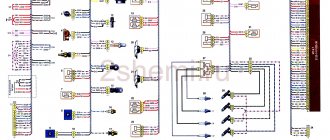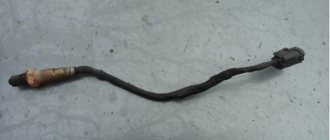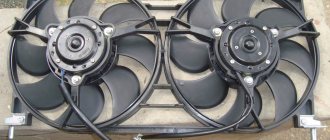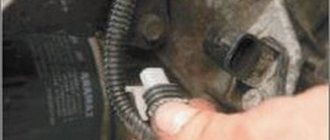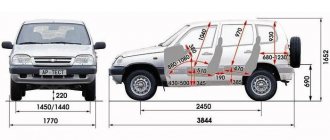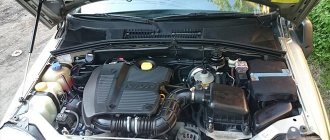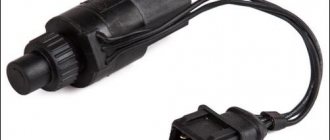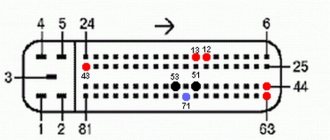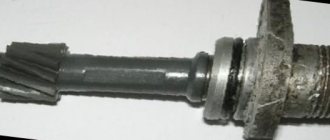09 February 2015 Lada.Online 244 238 96
In order for the car to comply with more stringent environmental standards, AVTOVAZ equips modern Lada cars (Priora, Granta, Kalina, Niva, Largus, Vesta and XRAY) with an electronic gas pedal or “E-gas”. The throttle valve drive got rid of the cable and became equipped with a gear motor. As a result, the gas pedal has no mechanical connection with the throttle valve, and engine control has become completely electronic.
Basic functions and purpose of the speed sensor
To control the speed of movement, a special device is installed on the dashboard - a speedometer.
But it only displays the information received, and the speed sensor is responsible for collecting data. If it fails, it will create many dangerous situations on the road, since it will become difficult to control the speed limit in the city and on the highway. But besides this, thanks to the integration of the electronic control unit into the system, the speed sensor allows you to perform the following functions:
- fuel consumption control
- displaying information on the instrument panel
- in cars with an automatic transmission it is included in the complex responsible for engine control
In case of failure, you are allowed to continue the journey, but this will become difficult.
Historically, there were two types of sensors. Initially, mechanical or optoelectronic were used. They read the number of shaft revolutions, transmitting it to the instrument panel using a cable. Then electronic cableless systems came to replace them.
Each car has a speedometer in its design, which displays the speed of movement of the vehicle. But the speedometer is only a display of useful information; the main function of indicating the speed of movement is performed by the sensor. If it malfunctions, further travel becomes a pain, especially on city highways, where it is necessary to maintain the speed of movement.
Therefore, the main function of the device is to read information about the movement of the vehicle. Indirect functions of the device include:
- possibility of rational fuel consumption;
- regulation of traffic according to road markings and signs;
- makes it possible to regulate speed in order to avoid fines.
It is possible to drive a car without this part, but it is quite difficult.
There are two types of speed sensors:
- Mechanical or optoelectronic. It works by transmitting the number of revolutions of the box shaft using a cable.
- Electronic or cableless. Actually, that’s what we’ll be talking about.
A speedometer is installed in the design of almost every car. But the speedometer is only a general display that displays information. The main function of indicating speed is performed by the sensor itself. If the device is faulty, further movements become very difficult, if possible at all. The part needs to be replaced as quickly as possible.
The main purpose of the device is to read information related to moving around the city. There are other, so-called indirect functions:
- Adjust speed to avoid fines.
- Simplified traffic following road markings and signs.
- Rational fuel consumption. It is also important for cars produced in 2007.
Without this part, driving a car is possible, but it becomes much more difficult.
A speedometer is installed on the Niva's instrument panel, which is necessary to display the current speed of the car. In the event of a malfunction, driving becomes difficult as most roads have speed limits that must be followed. In addition, a malfunction of the speedometer can affect the calculation of other data by the on-board computer. Based on the DS data, the required fuel consumption is determined and gasoline savings are ensured while idling.
Therefore, it is necessary to carry out diagnostics as soon as possible and identify the cause of the breakdown.
Electronic engine control unit (ECU)
An ECU is a kind of computer in a car; it is in this device that the entire operation of the internal combustion engine is corrected. All sensors that are installed in the car transmit readings specifically to this unit, and based on the readings, it makes changes to the operation of the engine, which affects both the engine speed and its consumption.
Symptoms of ECU malfunction:
There can be a huge number of signs of malfunction of this unit, because signs of failure of one sensor may even indicate failure of the unit.
Operating principle of the electronic pedal
The speed sensor for Niva 21214 is based on the action described by physicist Hall. It reads electromagnetic pulses, which are then processed by the on-board computer. One kilometer of travel is equal to 6000 pulses sent by the DS, and if the speed increases, the frequency of the pulses increases. As a result, calculations occur in a special controller, which provide information to the instrument panel in a more convenient form.
A gearbox, an electric motor and two sensors are built into the throttle body. The electric motor turns the throttle valve through a gearbox, and its position is monitored by two sensors.
The electronic gas pedal is a plastic lever, and two sensors are installed in the bracket. All elements are a single structure (gas pedal module). The sensors are potentiometers, the moving contact of which is rigidly connected to the rotary axis of the pedal lever.
Also interesting: Chevrolet Niva speed sensor: where is the Chevy Niva located, speed sensor pinout, connection diagram and how to protect it, replacing the speedometer sensor
The electronic control unit (ECU) continuously monitors the pedal position based on sensor signals. Based on these parameters, the ECU sends control commands to the throttle gearbox and to the fuel injectors.
The Hall effect is the principle of reading electromagnetic pulses. There are magnetic marks on the car shaft, the impulse from which is read by the sensor. A certain number of shaft rotations is programmed into the control unit, corresponding to the kilometer traveled, equal to 6004. As the speed increases, the interval between pulses is reduced, the information is processed and displayed on the instrument panel.
Coolant temperature sensor (DTOZH)
DTOZH on Niva is installed in the cylinder head outlet pipe. The coolant temperature sensor is a fairly simple element in its design. The sensor is based on a thermistor, which changes its resistance as the temperature changes.
One of the functions of the sensor is to start the electric engine cooling fans when the coolant temperature threshold is reached. The sensor is also responsible for starting the engine in cold weather; according to the coolant temperature readings, the electronic control unit forms the fuel mixture necessary for more proper warming up of the car engine. This can be replaced by the presence of high warm-up speeds at the moment of starting the internal combustion engine.
Signs of DTOZh malfunction:
- Cooling fans do not work;
- No warm-up speeds;
- Difficulty starting the internal combustion engine;
- Increased fuel consumption;
Where is the speed sensor located in the Chevrolet Niva and design features
The gearbox is where the speed sensor is mounted in the case of the Chevrolet Niva. The guidance of electromagnetic pulses inside the device is ensured by the rotation of the gearbox shaft.
The design of the sensor itself is formed by just a few simple elements:
- conductors;
- internal components;
- housing, on a steel or plastic base - connection using it is the safest.
Attached directly to the shaft, with the participation of the gearbox. Inside there is a core of ferromagnets. It is this part that rotates, creating impulses when the car moves. The pulses travel along the conductor to the controller located on the sensor.
Stages of work execution
Chip tuning of the Chevrolet Niva, according to reviews, consists of the following steps:
you need to read a portion of the necessary data that is located in the ECU controller;
make the necessary adjustments to the program;
write updated data to the controller.
This correction allows you to obtain the following results:
increase the total power and dynamics of the engine;
ensure smooth movement without jerking.
The reprogramming procedure takes several hours to complete. During such work, mechanical intervention is not required.
Advantages and disadvantages of an electronic pedal
Pros:
- Instant engine response when you press the gas pedal.
- Smoothing out sharp gas changes.
- Reduced fuel consumption.
- Environmentally friendly.
Minuses:
- Non-repairable.
- Slower acceleration.
- Softer pedal.
What do you think about the electronic gas pedal on Lada cars? Maybe it would be better if the gas pedal has a cable? Let us remind you that some problems with E-Gas are solved after replacing the brake pedal position sensor.
Keywords: granta fret pedals | Lada Priora pedals | fret Kalina pedals | 4x4 pedals | fret vesta pedals | pedals lada xray | fret largus pedals | universal article
Found an error? Select it and press Ctrl Enter..
Firmware performance
Successful implementation of such tuning will lead to the following results:
fuel will be saved significantly, ranging from one and a half to two liters per 100 km;
engine functionality will improve;
the machine will run smoothly, without jerking.
To perform flashing, use the ChipExplorer editor, which is available for download on the Internet. Such a program is offered for sale in a car dealership. It is important to know how such tuning is performed. If you lack confidence in your abilities, it is better to seek professional help.
Signs of malfunction and methods of failure
Like any car part, the sensor is subject to vibration and is susceptible to contamination and oxidation. Therefore, its failure is possible from time to time. To understand the cause of the breakdown and what to do in each specific situation, the following problems should be eliminated:
- broken wiring
- the appearance of oxide on the contacts
- destruction of wire insulation
- mechanical damage to the housing or its internal components
To do this, you can carry out a certain set of measures to check the condition of the sensor. Typically, such work requires a multimeter. The sensor is removed from the seat. A positive probe is connected to the contacts. The negative one is connected to the ground of the vehicle. The multimeter must be set to minimum power measurement mode.
There is a second diagnostic method. This does not require dismantling the sensor. The car is raised with a jack, then a multimeter is connected to the sensor. To appear, you need to rotate the wheel, observing the readings of the device. If the value does not change, the sensor is faulty.
In the Niva Chevrolet, the speedometer needle is driven not by a cable and a magnetic device, as in classic VAZs, but by electronics. The speedometer itself, like the rest of the instruments on the panel, are nothing more than voltmeters or ammeters with different scales.
This is for information, because it is useless to poke into the speedometer itself, it is not repairable and if at least one element fails, you have to buy the entire instrument panel on the circuit board.
The speedometer receives an impulse from the speed sensor, and it is installed on the transfer case housing. These impulses are also monitored by the electronic engine control unit and, receiving them, draws its conclusions about the operating mode of the motor.
The signs of a non-working speedometer are quite clear - the needle either lies shamelessly, showing 160 at a speed of 20 km/h, or twitches, or falls dead to the zero mark.
Since there are not many elements in the electrical circuit of the Chevrolet Niva speedometer, there are only a few reasons for the device not working:
- Mechanical damage to the speedometer itself.
- No contact in any of the terminal connections.
- Broken or shorted wire.
- Failure of the speed sensor.
- ECU malfunction.
Also interesting: Chevrolet Niva won’t start: the reason, what to do?
Problems with DS arise from time to time, but not all of them require replacement. Some of them are caused by third-party reasons, such as:
- oxidation of contacts,
- wire break,
- damage to wire insulation,
- damage to gearbox mechanisms.
If a breakdown occurs, it can be indirectly determined by the following signs:
- If your car has a cruise control system, it stops working. The electronic unit forcibly turns it off to ensure safety.
- Forced disabling of the power steering on the car.
- Reduced power and other dynamic characteristics of the car. This is noticeable in poor overclocking and malfunctions when the load increases. Damage is noticeable when towing loads.
- Reduced idle speed or “floating” indicators. A sharp decrease in performance also occurs in the event of braking. Sometimes the engine itself is forced to shut down while driving.
- Increased fuel consumption due to the choice of a less than optimal operating mode.
- Check Engine Light Activation.
- Some cars face forced restrictions on maximum speed or available revolutions.
- Forced disabling of the anti-lock braking system.
- Spontaneous gear shifting in jerks. Such actions are carried out randomly, since the car itself cannot establish optimal performance for the present moment.
- Lack of normal operation of the speedometer - completely or partially.
The listed symptoms are often characteristic of breakdowns in other components that the car is equipped with. It is recommended to use a special scanner for comprehensive diagnostics of the entire circuit.
The sensor itself rarely fails because it is a reliable device. But its operation may be negatively affected by the following factors:
- The sensor is dirty from the inside. Such problems are especially common with sensors with detachable housings.
- Metal shavings get on the device. Sometimes this reason appears in devices supported by permanent magnets.
- Interference from other devices.
- Problems related to fixation. The scheme must take into account the color of each individual part.
- The integrity of the wiring is broken. For example, if it overheated, or some mechanical damage appeared inside. In this case, the contacts are completely cleaned of traces of corrosion, then a special protective lubricant is used for them.
- Oxidation of contacts. The phenomenon is attributed to natural factors, often arising simply from time to time.
- Overheating that occurs during direct operation. This happens even if the pinout is initially correct.
Idle air control (IAC)
This sensor is located, just like the TPS, on the Niva’s throttle valve. The essence of the sensor's operation is to open and close the channels through which air flows to operate at idle speed. The IAC is involved in the operation of the internal combustion engine only at idle; when the speed increases, the regulator is switched off. IAC is a kind of DC motor with worm gear. Quite often the sensor fails. Subsequently, this sensor was abandoned in favor of an electronic throttle.
Signs of IAC malfunction:
Location of the Chevrolet Niva speed sensor
Currently, the production of automobiles has completely abandoned the use of speed measurement sensors consisting of mechanical parts. Modern devices are based on the use of electromagnetic sensors that work due to the effect discovered by the physicist Hall and which received the same name.
The work is carried out in an inspection pit. Before dismantling, you must disconnect the battery.
The sensor is located on the rear cover of the transfer case. Before removing it, you must disconnect the terminals. They are held in place by a plastic retainer.
Then, using a wrench, the device is unscrewed from the seat.
If the device is firmly “stuck”, it is forbidden to use excessive force; it is better to treat the threads with a lubricant like WD-40.
Before installing a new device, you should carefully examine its condition. On the sensor, the assembly points and contact group must be carefully filled with varnish to prevent the penetration of water. Otherwise, the device may soon fail.
The speed of a car has long been measured not mechanically, but electronically. This measurement is based on the principle of the Hall effect, using a special device. The Chevrolet Niva is equipped with the same electronic device, which accurately reads the speed developed by the car.
The ECU uses information from the mass air flow sensor to determine the duration of the injector opening pulse.
After identifying the problem, further actions depend on the reason for the problems in the work.
The following options are available to correct the current situation:
- Dismantling the device, checking with a multimeter. The signal screen is also easy to disassemble. In case of serious malfunctions, it is easier to replace the device; repairs will be too expensive. The main thing is to dismantle the dashboard in advance to gain access to the interior panel of the car. The fixing nut from the device is also completely removed. After this, disconnecting the sensor itself will not be difficult.
- Additional check on sensor contacts. Contamination or oxidation of contacts remain the causes that car owners encounter most often.
- Examination of the sensor circuit to ensure integrity is maintained. To do this, take a multimeter and test the wires. Problems are usually associated with a short circuit or break in the contacts. It is best to replace damaged wires immediately, as they can operate in high temperatures, causing the connection to deteriorate.
Also interesting: How to check the generator on your own: checking the generator without removing it from the car, relay regulator, diode bridge
To remove the DS, you need to place the car on a level surface. After this, it is best to disconnect the battery terminals to avoid errors in the BC.
Disconnect the wire terminals; to do this, press the plastic lock on the block. After this, use a wrench to unscrew the sensor from its seat. If you cannot unscrew it immediately, it is not recommended to use excessive force. You need to treat the threaded connection with WD-40, wait a few minutes and continue dismantling.
Installation of a new DS is carried out in the reverse order. When purchasing a new part, you need to pay attention to the external condition: the contacts must be treated with a sufficient amount of varnish, as this protects them from moisture. After completing the work, it is necessary to reset the on-board computer errors in order to remove the CHECK ENGINE error.
Benefits of Execution
Chip tuning of the Chevrolet Niva engine allows you to obtain many tangible advantages:
significantly increase engine power - turbocharged power plants are strengthened by almost 35%, engines in which turbocharging is not provided - by almost 7%;
provided that an experienced specialist is involved in the work, carry out all operations as quickly as possible;
significantly increase dynamic acceleration performance;
using firmware, you can remove those restrictive settings that prevent the vehicle from accelerating to maximum speed;
Now you can reconfigure the engine, change the type of fuel it consumes, for example, AI - 92 to AI -95.
After flashing the Chevrolet Niva ECU, you can always return to the factory settings.
Location of the Chevrolet Niva speed sensor
Each vehicle is equipped with only the appropriate equipment, designed for a certain number of shaft rotations and installed in the appropriate seat. The Chevrolet Niva speed sensor is installed on the gearbox.
The sensor itself is a small steel or, more often than not, plastic device that is mounted in the shaft area. Inside the case there is a core that transmits impulses to a special controller responsible for displaying information on the instrument panel.
When carrying out work, it should be taken into account that the device can be quite fragile, so installation should be carried out with care.
On Niva DS is installed on the gearbox. This allows data to be read only while driving, turning off when the engine is in neutral.
The device itself consists of a plastic case, inside of which electronic components are located. For proper operation, it is placed in close proximity to the shaft. There is a built-in magnetic bar inside the shaft that creates electrical signals when rotated.
The product is quite fragile, so when dismantling or installing you must be extremely careful not to damage its body.
Crankshaft position sensor (CPS)
The Niva DPKV is installed in a special hole in the oil pump drive cover. This sensor is responsible for setting the ignition timing. The sensor takes readings from the crankshaft pulley, which has teeth and in one of the places there is “caries”, that is, several pulley teeth are missing. It is “caries” that the DPKV understands in what position the crankshaft is. The sensor itself resembles an inductive coil, which generates impulses when the crankshaft rotates and transmits them to the computer.
Checking the sensors.
In order to check the DC, you need to have a multimeter, then follow a certain procedure:
- Turn off the sensor.
- We connect the red (positive) probe to the DC contact.
- We connect the black (negative) probe to ground.
- We fix a tube of suitable diameter onto the shaft in order to be able to rotate it.
- We switch the multimeter switch to low voltage measurement mode.
- It is necessary to rotate the shaft and observe the readings: as the speed increases, the readings on the multimeter display will increase. If the readings do not change, the sensor is faulty.
Another method does not require removing the sensor. To do this, you need to jack up one wheel so that it is at a distance from the ground and can rotate freely. After this, you need to connect a multimeter to the DC connectors. You need to rotate the wheel and observe the readings of the device. A change in voltage will also indicate performance.
Reviews from “traditional craftsmen”
Do-it-yourselfers who have experience doing Chevrolet Niva chip tuning with their own hands often say that such work did not make sense. They claim that the engine is capable of adapting to existing conditions, “self-learning.” Indeed, this is typical for Bosch ECU models 7.9.0 and M 7.9.7, as well as M 7.9.7+. But if the “January” block of model 7.2 is installed in the engine, it is quite advisable to perform a flashing, changing all the factory settings. Then the engine power indicators can increase up to 10%. It is advisable to entrust such work to a specialist. The final quality directly depends on this. This way you can avoid negative consequences.
About the price
Car enthusiasts who are interested in the question of how much a new Chevrolet Niva costs will be interested to know that the price starts from 630,000 rubles and above, depending on the chosen modification.
Work on reflashing the ECU will cost the vehicle owner in the amount of 5,000 to 6,500 rubles. If the driver is confident in his abilities, he can use a special program and reflash the engine himself. But mistakes in such a matter are extremely undesirable.
